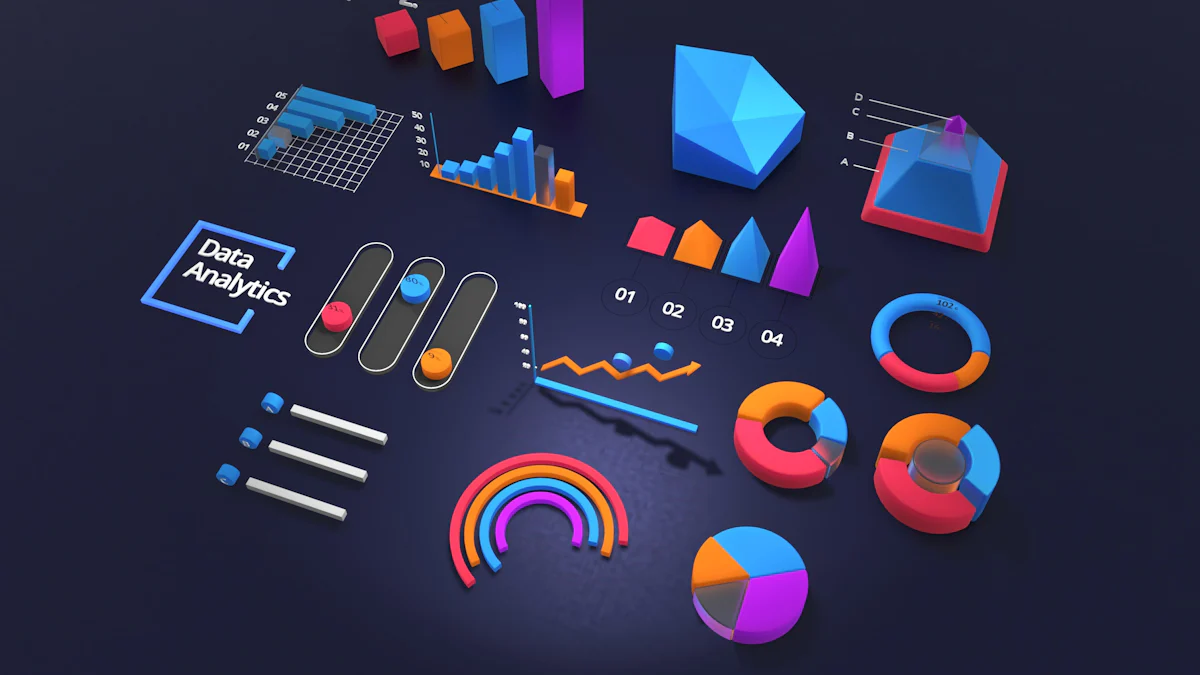


Traffic sources refer to the various channels that direct visitors to your website. These include organic search, social media, email marketing, and paid advertising. Understanding traffic sources is crucial for boosting your online presence. Knowing where visitors come from helps you refine your digital marketing strategies. Traffic sources play a vital role in digital marketing by providing insights into visitor behavior. This understanding aids in evaluating website performance and making informed decisions. Organic search often tops the list for generating website traffic, highlighting the importance of quality content and SEO.
Understanding Traffic Sources

Definition of Traffic Sources
Traffic sources guide visitors to your website. Each source offers unique benefits and challenges. Let's dive into the different types.
Organic Traffic
Organic traffic comes from search engine results. Visitors find your site without paid ads. This traffic often brings high-quality leads. Search engines like Google rank your content based on relevance. High rankings mean more organic traffic.
Direct Traffic
Direct traffic arrives when users type your URL directly. This group includes loyal visitors who know your brand. Direct traffic shows strong brand recognition. Tracking direct traffic helps you understand brand loyalty.
Referral Traffic
Referral traffic comes from other websites. These sites link back to your content. Quality backlinks boost referral traffic. This traffic can improve your site's authority. Optimizing referral sources enhances visitor flow.
Paid Traffic
Paid traffic involves advertisements. You pay for clicks or impressions. Ads appear on search engines or social media. Paid traffic provides quick results. However, costs can add up quickly. Balancing paid and organic traffic is key.
Types of Traffic Sources
Traffic sources vary in nature. Different platforms offer unique ways to attract visitors. Let's explore some common sources.
Search Engines
Search engines drive significant traffic. Google, Bing, and Yahoo are popular choices. SEO strategies improve search engine visibility. Keywords and quality content play vital roles. Search engines reward relevant and optimized sites.
Social Media
Social media platforms connect with audiences. Facebook, Instagram, and Twitter lead the pack. Engaging content attracts social media traffic. Sharing and interactions boost visibility. Social media builds brand awareness and community.
Email Campaigns
Email campaigns target specific audiences. Newsletters and promotions reach subscribers. Personalized emails increase engagement. Email traffic nurtures customer relationships. Effective campaigns drive repeat visits.
Display Advertising
Display advertising uses visual ads. Banners and videos catch attention. Ads appear on various websites. Display ads enhance brand recognition. Targeted ads reach specific demographics.
Importance of Traffic Sources
Understanding traffic sources plays a crucial role in your website's success. Let's explore how these sources impact performance and business growth.
Impact on Website Performance
Traffic sources directly influence how users engage with your site. Each source offers unique interactions that affect overall performance.
User Engagement
User engagement depends on where visitors come from. Organic traffic often leads to higher engagement because users actively search for your content. Referral traffic also boosts engagement by bringing interested visitors from trusted sites. A survey showed that 98% of publishers find referral traffic significant for engagement. Focusing on these sources can enhance user interaction.
Conversion Rates
Conversion rates measure how well your site turns visitors into customers. Traffic sources like paid ads provide quick results but may not always lead to high conversions. Organic and referral traffic often result in better conversion rates. These visitors usually have a genuine interest in your offerings. Understanding which sources drive conversions helps optimize marketing efforts.
Business Growth and Revenue
Traffic sources contribute significantly to your business growth. Knowing where your audience comes from aids in strategic planning.
Customer Acquisition
Customer acquisition relies heavily on diverse traffic sources. Organic search and social media bring in new customers by increasing visibility. Email campaigns target specific audiences, nurturing potential leads. Publishers expect referral traffic to rise, indicating its growing importance in acquiring customers.
Brand Awareness
Brand awareness grows when you leverage multiple traffic sources. Social media and display advertising boost recognition through engaging content. Direct traffic reflects strong brand loyalty, showing that users remember and trust your brand. Building awareness across different channels ensures a broader reach and stronger market presence.
Analyzing Traffic Sources
Understanding traffic sources helps you improve your website's performance. Let's explore some tools and metrics that can guide your analysis.
Tools for Traffic Analysis
Google Analytics
Google Analytics offers a comprehensive view of your website traffic. This tool shows where visitors come from and what they do on your site. You can track traffic channels, visitor numbers, and page views. Use the Traffic Sources Overview section to see detailed insights. This information helps you identify which pages need improvement and how to boost conversion rates.
SEMrush
SEMrush provides in-depth analysis of your traffic sources. This tool helps you understand search traffic and keyword performance. SEMrush breaks down referral traffic into categories like social media mentions and blog links. This granular data allows you to refine marketing strategies and optimize lead generation.
Metrics to Consider
Analyzing specific metrics gives you a clearer picture of your website's health. Here are two key metrics to focus on:
Bounce Rate
Bounce rate measures the percentage of visitors who leave your site after viewing only one page. A high bounce rate may indicate that your content isn't engaging enough. Improving this metric can enhance user experience and increase conversions.
Session Duration
Session duration tracks how long visitors stay on your site. Longer sessions often mean more engagement and interest in your content. Monitoring this metric helps you understand what keeps users on your site and how to replicate that success across other pages.
Strategies to Optimize Traffic Sources

SEO Best Practices
Keyword Research
Keyword research forms the backbone of effective SEO. You want to find terms that potential visitors use when searching online. Tools like Google Keyword Planner help identify these valuable keywords. Aim for a mix of high-volume and long-tail keywords. This approach captures both broad and specific search intents. Regularly update your keyword list to stay relevant.
On-page Optimization
On-page optimization ensures that your website aligns with search engine requirements. Focus on elements like title tags, meta descriptions, and header tags. These components should include your target keywords. Use clear and concise language to describe your content. Ensure that images have alt text for accessibility. A well-optimized page improves search engine rankings and enhances user experience.
Social Media Marketing
Content Strategy
A solid content strategy boosts your social media presence. Create engaging and shareable content tailored to your audience. Use a mix of text, images, and videos to keep things interesting. Plan your posts using a content calendar. Consistency helps maintain audience interest and engagement. Social media SEO involves incorporating keywords into your posts. This tactic increases visibility and reach.
Engagement Tactics
Engagement tactics encourage interaction with your audience. Respond promptly to comments and messages. Show appreciation for user-generated content by sharing or liking it. Host contests or giveaways to spark interest. Use polls and questions to invite feedback and opinions. Engaged audiences often become loyal followers and advocates for your brand.
Challenges in Managing Traffic Sources
Identifying Accurate Sources
Traffic sources can sometimes be tricky to pinpoint. You might wonder why this matters. Knowing where your visitors come from helps you focus your strategy. Let's dive into some common challenges.
Attribution Models
Attribution models help you understand which source gets credit for a conversion. This can be confusing. Different models give different results. Some models give all the credit to the first interaction. Others focus on the last click. Choosing the right model is crucial. It affects how you allocate your marketing budget. You need to test various models. Find the one that aligns with your business goals.
Data Discrepancies
Data discrepancies occur when your traffic data doesn't match up. This can happen for several reasons. Maybe tracking codes aren't set up correctly. Or perhaps users block cookies. These issues can skew your data. Accurate data is vital for making informed decisions. Regular audits of your tracking setup can help. Ensure everything is working as it should.
Adapting to Market Changes
The digital landscape changes rapidly. Staying ahead requires adaptability. Let's explore some factors that can impact your traffic sources.
Algorithm Updates
Search engines frequently update their algorithms. These updates can affect your organic traffic. A sudden drop in rankings can be alarming. Keeping up with these changes is essential. Regularly update your SEO strategies. Focus on quality content and user experience. This approach helps you weather algorithm shifts.
Consumer Behavior Shifts
Consumer behavior doesn't stay static. Trends change, and so do preferences. Social media platforms rise and fall in popularity. Email open rates fluctuate. Understanding these shifts is key. Monitor industry trends and consumer feedback. Adjust your marketing tactics accordingly. Staying flexible keeps you aligned with your audience's needs.
Additional Resources of Traffic Sources
Books and Articles
Recommended Reading
Books and articles offer valuable insights into traffic sources. "Digital Marketing for Dummies" provides a comprehensive guide. This book covers various aspects of digital marketing, including traffic sources. "SEO 2023: Learn Search Engine Optimization" by Adam Clarke focuses on SEO strategies. Readers can learn how to boost organic traffic. Articles from HubSpot and Moz provide up-to-date information. These resources help you stay informed about the latest trends.
Online Courses and Tutorials
Learning Platforms
Online courses and tutorials offer practical learning experiences. Coursera provides courses on digital marketing. These courses cover topics like SEO and social media marketing. Udemy offers a wide range of tutorials. Learners can find specific courses on traffic sources. LinkedIn Learning features expert-led classes. These classes focus on improving website traffic. Engaging with these platforms enhances your understanding of traffic sources.
Understanding traffic sources is crucial for optimizing your website's performance. You can identify which sources drive the most valuable traffic. This knowledge helps you refine your marketing strategies and boost conversions. Apply these insights to enhance your digital marketing efforts. Dive deeper into advanced traffic analysis techniques. Explore tools and methods that provide detailed insights into audience behavior. Embrace this understanding to prioritize and focus on what truly works for your online presence.
FAQ
Traffic sources include organic, direct, referral, and paid. Organic traffic comes from search engines. Direct traffic involves visitors typing your URL. Referral traffic comes from other websites. Paid traffic involves ads that you pay for.
Knowing your traffic sources helps improve your marketing strategies. You can see where your visitors come from. This information lets you focus on channels that work best. You can also identify areas needing improvement.
Focus on SEO to boost organic traffic. Use keyword research to find terms people search for. Create high-quality content that answers questions. Regularly update your website to keep it fresh. Search engines love relevant and updated sites.
Social media connects you with a broad audience. Platforms like Facebook and Instagram drive traffic through engaging content. Share posts that resonate with your audience. Encourage interactions to boost visibility.
Referral traffic boosts brand authority. When other sites link to yours, it shows trust. Quality backlinks enhance your site’s credibility. This trust leads to more visitors and potential customers.
Tools like Google Analytics and SEMrush provide insights. Google Analytics shows visitor behavior on your site. SEMrush offers detailed traffic source analysis. These tools help refine your marketing strategies.
A balanced approach ensures stability. Use paid traffic for quick results. Focus on organic traffic for long-term growth. Diversify your strategies to reduce reliance on one source. This balance helps maintain consistent traffic flow.
Challenges include data discrepancies and market changes. Tracking errors can skew data. Algorithm updates affect search rankings. Stay informed and adapt strategies to overcome these hurdles.
Continue Reading About Traffic Sources
10 Must-Have Marketing Agency Reporting Tools for Your Success
Optimize your agency's performance with top reporting tools. Explore analytics, social media, SEO, and more for data-driven decisions and efficiency.
Lewis
Oct 09, 2024
10 Game-Changing Project Management Reporting Types!
Unlock project success with 10 must-know reporting types! Track progress, manage risks, and stay on budget like a pro.
Lewis
Mar 03, 2025
15 Best Software Reporting Tools for 2025
Explore the top 15 software reporting tools for 2025. Compare features, pricing, and usability to find the best fit for your business needs.
Lewis
Oct 08, 2024
Augmented Analytics: Unlock the Core Concepts & Benefits!
Discover augmented analytics—where AI and ML automate data prep and insights, revolutionizing decision-making for smarter, faster business strategies!
Lewis
Mar 04, 2025
Which Data Analysis Projects Work Best for Beginners?
Ready to shine in 2025? Discover easy data analysis projects to boost your portfolio, learn data cleaning, visualization, and tackle real-world challenges!
Lewis
Mar 10, 2025
Best Data Integration Vendors for Seamless Workflows
Discover the top 20 data integration vendors of 2025 for seamless workflows. Compare tools like Talend, AWS Glue, and Fivetran to optimize your data processes.
Howard
Jan 22, 2025


